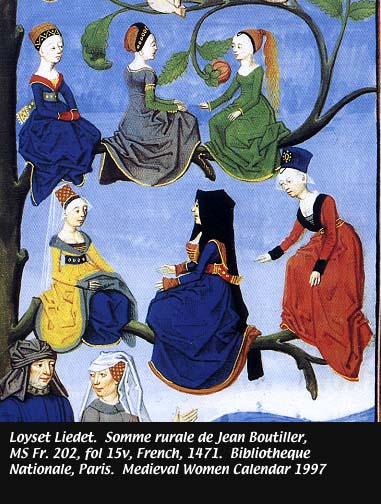

Ever since the Medieval Women Calendar for 1997 came out, the hat-maven community has been wondering about the black headband-with-loop seen on the girl with the ponytail.
There are a few other pictures of women wearing this headband; one is at Hope Greenberg's site (which has lots of other great pictures.
So what was this headband for? Was it the source of all those black loops in pictures of the outrageous hats? We may never know, but the general theory held by the costume folks is that it was a base on which was pinned, hooked, or sewn, the rest of the hat, and somehow helped keep the thing on.
"Ancient" costume historians -- by which I mean prior to the more rigorous academics that showed up in the latter part of the last century, thought that the loop was heavy enough to by itself, counterweight the hat. I have long doubted this, because the loop would need to be very heavy indeed to do so. After my first attempt at such a hat, when I had to hide a pound of BBs in the front of the thing to counterweight it, it was clear that no little loop of even the heaviest commonly available metal, lead, would be able to serve this function. I was amongst those intrigued by this picture, and the others that were found.
I have a theory about the headband, which I'll illustrate with overly-simplified diagrams.
The human head can be roughly approximated by a globe. It's actually
more egg-shaped, with the chin being the pointy end and the crown/back
of the head being the globular end, but for the purposes of illustration,
I have used a circle, which is meant to represent the globe.
| Here is a head. The red line represents the equator -- the largest circumference around the head. A band fitted on this circumference can slip forward, and it can slip backwards. |  |
| The added blue line represents a different, offset
circumference, which is smaller than the equator line. A band fitted
on the blue line can slip forward, but not backward, because the band would
need to be larger than it is to slip over the equator line. If you
were to pin a heavy hat to the blue band, it would not be able to slip
backwards. Success! Or is it? How do you get the blue
band onto your head in the first place?
There are a couple of ways: 1: It has an opening, such as with hooks or pins. Such a headband would have to be fairly flexible. However, these hats have high forehead clearances. The blue line is low on the forehead. (Even on a real forehead; try it yourself sometime with some ribbon.) It fails the aesthetics test. 2: The headband doesn't rest on the blue line, but rests along the red line. Such a headband would not need to be flexible, because it doesn't have to be manipulated much. But if it rests along the red line, it would fall off. |
 |
| Here, then, is my theory: the band rests on the red line, with a stiff metal loop, covered by fabric, that extends the angle of the band to effectively be on the blue line. The loop would be something that is slotted into the black band after the band is put on the head (resting on the red equator line) and extend far enough on the forehead to intersect the blue line. |  |
| Finally, somehow the hat (if a hat is worn) is mounted on the black band. It can't fall off the back, because it would have to stretch over the greatest circumference of the head. It can't fall off the front, because the weight of the hat holds it balanced backwards. |  |
| Also keep in mind an additional style possibility:
The hat may be shaped at the back of the neck to prevent it slipping backwards, because the extended base (as compared to a straight "bucket" shaped hat, pink line & arrow) is stopped by the top of the neck (black arrow.) A sculptured water pitcher in the shape of a woman with a trucate cone hat, at the Isabella Stewart Gardner Museum shows this sort of shaping on the hat base. This is shown here for the truncated cone style, but could easily be the case for the steeple/cone hat also. |
 |
Keep in mind that not all hats of the late fourtheenth and fifteenth centuries had these loops. Other methods may have been used, or possibly a combination of methods. My hats do not currently use this style; most of them stay on without help, or I use long hatpins to attach them to braids or buns under the hat.
The band may also be a sort of full-band comb, like some of the hairbands that you can buy in the stores these days. Some of the pictures seem to show the bands as decorated in their own right; it's possible that they were made to wear entirely on their own. Sadly, we'll probably never know for certain.
Make sure you check out my other articles about these complex hats;
there are lots of pictures from medieval manuscripts and other sources.
| All material © 2001 Cynthia Virtue | Email Author with comments |
| Back to Virtue Ventures Main Page | Back to Article Index |